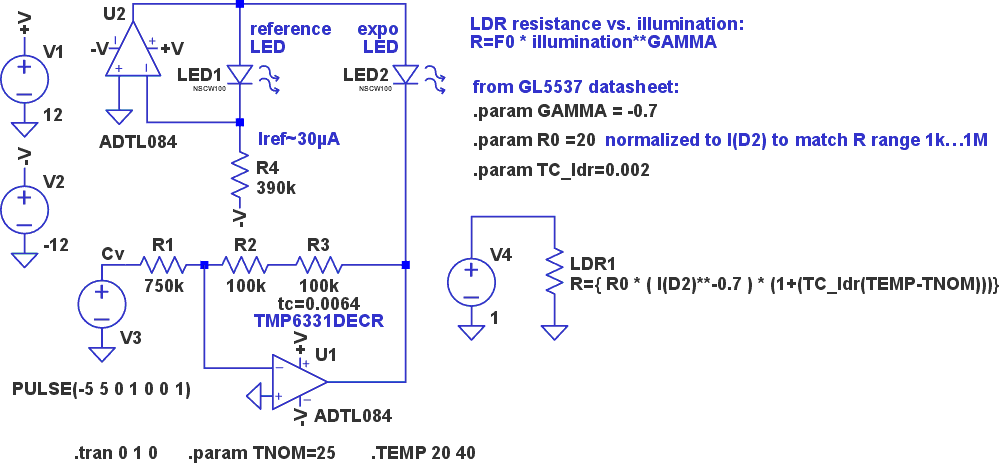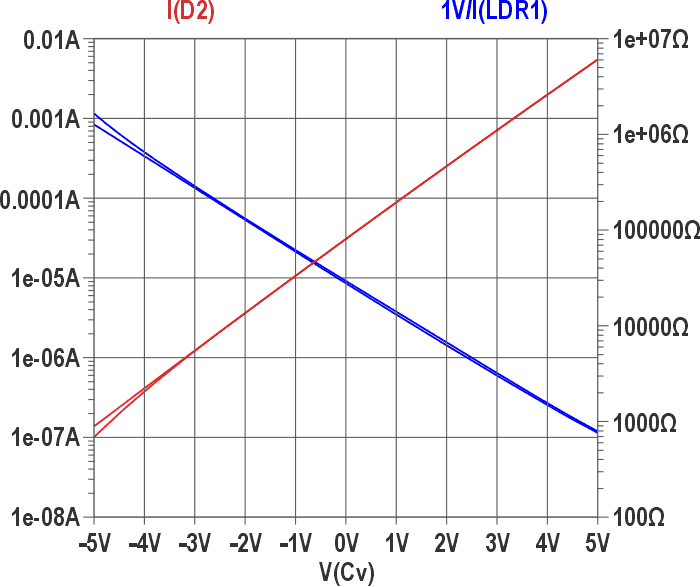Brief intro to vactrols
Vactrols, or both an LED and a light depending resistor (LDR) (Ref. 1) in a light-tight housing, are found in analog music electronics circuits like audio compressors, voltage-controlled amplifiers (VCAs), voltage-controlled filters (VCFs), and other applications.
Nowadays, analog ICs are used for this purpose, so vactrols have become quite rare. One of their main advantages was and remains the low large signal distortion compared to transistor circuits.
On the other hand, they are slow and sluggish when driven by small control currents and have a nonlinear characteristic curve.
Fortunately, the characteristic curve of the conductance versus control current is more linear than that of the resistance. This is advantageous, for instance, for VCFs with a frequency response proportional to 1/RC. For music electronics applications, however, exponential control of the conductance is preferred since voltage-controlled circuits use the “volt/octave” characteristic, whereby with each volt of additional control voltage, the cutoff frequency of the VCF doubles.
Another advantage of exponential vactrol control is the fact that the LED current never becomes 0 [y = exp(x) > 0] and thus the LDR never reaches its full dark resistance, which has a positive effect on the response time of the LDR.
A vactrol circuit
Usually, a pair of transistors (Ref. 2) is used to convert a linear control voltage into an exponential current. In the case of a vactrol, however, the pair of transistors can be replaced by the LED itself, which is like any diode a voltage-controlled exponential current source.
For temperature compensation, two matched LEDs are required, similar to the transistor circuit.
Figure 1 shows the simulated circuit of the exponential vactrol control.
 |
|
| Figure 1. | An exponential vactrol drive where a reference LED is used to convert a linear control voltage into an exponential current, and two matched LEDs are used for temperature compensation. |
The LED1 is operated with IREF = –V/R4. At CV = 0, the current in the vactrol LED2 is identical, and the resistance of the LDR is set to the middle of the desired resistance range via IREF, here about 30 µA.
As CV increases, the voltage at the cathode of LED2 decreases, but the voltage between the anode and cathode increases so that the LED current increases exponentially.
With a negative CV, the voltage across LED2 decreases accordingly, so that the LED current decreases exponentially. The range of the LDR resistance is determined by summing amplifier U1’s gain. In practical applications, a range of ~1 MΩ (CV = –5 V) to 1 kΩ (CV = +5 V), is used, so that a VCF can be tuned from 20 Hz to 20 kHz.
Thermistor R3 improves the temperature drift of the LED current. Still, the LDR’s temperature dependence remains at approximately 0.2%/K, which makes the vactrol circuit less suitable for high-end VCOs.
For other applications (VCF, VCA), the temperature drift is good enough, and in most cases, the thermistor can be omitted.
Figure 2 shows the simulated resistance curve and LED2 current at 20 °C and 40 °C.
 |
|
| Figure 2. | The simulated resistance curve and LED2 current at 20 °C and 40 °C. |
Practical notes
A small PCB was developed for the circuit. The SMD LEDs are standard white types in a 5730 case. Vactrol LED2 is on the PCB top side and illuminates two GL5537 LDRs, which are arranged at an angle of approximately 45 degrees above LED2.
By slightly bending the LDRs, they can be mechanically trimmed for matching resistance. A small black 3D-printed box and a PCB with black solder mask prevent external light from affecting the circuit. Circuits with two and four LDRs illuminated by one LED have been successfully tested to implement 2nd- and 4th-order VCFs.